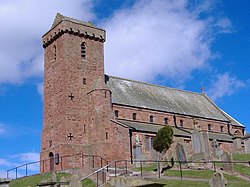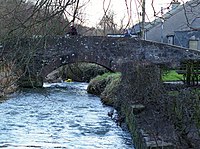St Vigeans: Difference between revisions
Created page with "{{Infobox town |name=St Vigeans |county=Angus |picture=St Vigeans Parish Church.jpg |picture caption=The parish church of St Vigeans |os grid ref=NO638429 |latitude=56.576634..." |
No edit summary |
||
| Line 14: | Line 14: | ||
|constituency=Angus | |constituency=Angus | ||
}} | }} | ||
'''St Vigeans''' is a small village and parish in [[Angus]], immediately to the north of [[Arbroath]], with which it shares a civil parish. Originally a rural village, St Vigeans is now more or less a suburb of the town of [[Arbroath]]. | '''St Vigeans''' is a small village and ancient parish in [[Angus]], immediately to the north of [[Arbroath]], with which it shares a civil parish. Originally a rural village, St Vigeans is now more or less a suburb of the town of [[Arbroath]]. | ||
The name St Vigeans is derived from ''Vigeanus'', a Latinised form of the Old Irish name Féichín, from the church's dedication to St Feichin, a 7th century saint. There is no record of his having visited Great Britain, let alone Angus, but followers of his cult may have founded a monastery among the Picts at St Vigeans as early as the 8th century. | The name St Vigeans is derived from ''Vigeanus'', a Latinised form of the Old Irish name Féichín, from the church's dedication to St Feichin, a 7th century saint. There is no record of his having visited Great Britain, let alone Angus, but followers of his cult may have founded a monastery among the Picts at St Vigeans as early as the 8th century. | ||
Revision as of 19:07, 8 October 2015
| St Vigeans | |
| Angus | |
|---|---|
 The parish church of St Vigeans | |
| Location | |
| Grid reference: | NO638429 |
| Location: | 56°34’36"N, 2°35’27"W |
| Data | |
| Post town: | Arbroath |
| Postcode: | DD11 |
| Dialling code: | 01241 |
| Local Government | |
| Council: | Angus |
| Parliamentary constituency: |
Angus |
St Vigeans is a small village and ancient parish in Angus, immediately to the north of Arbroath, with which it shares a civil parish. Originally a rural village, St Vigeans is now more or less a suburb of the town of Arbroath.
The name St Vigeans is derived from Vigeanus, a Latinised form of the Old Irish name Féichín, from the church's dedication to St Feichin, a 7th century saint. There is no record of his having visited Great Britain, let alone Angus, but followers of his cult may have founded a monastery among the Picts at St Vigeans as early as the 8th century.
The St Vigeans Sculptured Stones
The early presence of missionary monks is hinted at by the collection of more than thirty elaborately carved stones preserved in the St Vigeans Sculptured Stones Museum (converted from an old cottage) in the village (maintained by Historic Scotland; the key is at the Arbroath Abbey visitor centre). The collection includes cross-slabs, some with Pictish symbols, cross fragments, recumbents, and architectural fragments. It is one of the largest and finest of Pictish collections of its period, and includes stonework dating from the 8th-12th centuries. Most of the stones were recovered from the parish church, into whose walls they had been incorporated as building rubble during the Middle Ages, during 19th century 'restoration' work. Further fragments remain in the church's walls.
A monastic context for the St Vigeans' sculptures is suggested by some of the stones showing representations of clerics and patristic scenes. The so-called "Drosten Stone" features a much-analyzed Hiberno-Saxon inscription.
The presence of a formerly important, but moribund or redundant, monastic establishment at St Vigeans may have led King William I of Scots to found nearby the Tironensian monastery of Arbroath Abbey, the former monastery's lands being donated to the new foundation.
Parish church
St Vigeans Church[1] served as parish church to the inhabitants of Arbroath up to the Reformation. Built of the local red sandstone, it was a large and impressive example of a Scottish mediæval parish kirk.
The situation of the churhc on top of a prominent, steep-sided mound (presumably of glacial origin, though doubtless 'improved' by landscaping) is striking. Dating in part from the 12th century, but largely 15th century in date, the church unfortunately underwent a drastic 'restoration' in the late 19th century which, while it uncovered many Pictish fragments, also replaced most of the original architectural features of the church.
The church retains its internal round-pillared arcades, but all the doors and windows were renewed, so their original appearance has been lost. The western tower was also heightened and 'improved' by adding a castellated top and cap-house. The 18th century headstones in the kirkyard, some of which are notably well-carved, are interesting examples of folk-art, characteristic of Angus.
There was once a legend that the kirk was built with stones used by an enslaved Kelpie, and for several years the local congregation would not enter the kirk during certain services for fear the building would collapse due to the Kelpie's curse.
About the village

The old village of St Vigeans consisted of a single street of red sandstone cottages flanking the foot of the church mound. These have been attractively restored and are well maintained. The Brothock Burn runs past the village and so through Arbroath (formerly known as Aberbrothock amongst other variants), and is crossed by a bridge of 17th-century origin.
The village lacks a shop or post-office, but does have a large public hall.